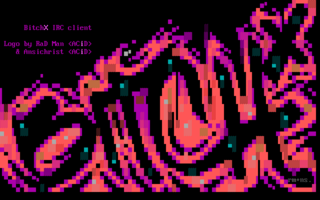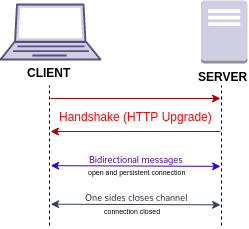
BitchX is a free IRC client that has been regarded as the most popular ircII-based IRC client. The initial implementation, written by "Trench" and "HappyCrappy", was a script for the IrcII chat client. It was converted to a program in its own right by panasync. BitchX 1.1 final was released in 2004. It is written in C and is a TUI application utilizing ncurses. GTK+ toolkit support has been dropped. It works on all Unix-like operating systems, and is distributed under a BSD license. It was originally based on ircII-EPIC, and eventually it was merged into the EPIC IRC client. It supports IPv6, multiple servers and SSL, and a subset of UTF-8 with an unofficial patch.

IRC is a text-based chat system for instant messaging. IRC is designed for group communication in discussion forums, called channels, but also allows one-on-one communication via private messages as well as chat and data transfer, including file sharing.
The Simple Mail Transfer Protocol (SMTP) is an Internet standard communication protocol for electronic mail transmission. Mail servers and other message transfer agents use SMTP to send and receive mail messages. User-level email clients typically use SMTP only for sending messages to a mail server for relaying, and typically submit outgoing email to the mail server on port 587 or 465 per RFC 8314. For retrieving messages, IMAP is standard, but proprietary servers also often implement proprietary protocols, e.g., Exchange ActiveSync.

ChatZilla is an IRC client that is part of SeaMonkey. It was previously an extension for Mozilla-based browsers such as Firefox, introduced in 2000. It is cross-platform open source software which has been noted for its consistent appearance across platforms, CSS appearance customization and scripting.

Extensible Messaging and Presence Protocol is an open communication protocol designed for instant messaging (IM), presence information, and contact list maintenance. Based on XML, it enables the near-real-time exchange of structured data between two or more network entities. Designed to be extensible, the protocol offers a multitude of applications beyond traditional IM in the broader realm of message-oriented middleware, including signalling for VoIP, video, file transfer, gaming and other uses.
In computer networking, Layer 2 Tunneling Protocol (L2TP) is a tunneling protocol used to support virtual private networks (VPNs) or as part of the delivery of services by ISPs. It uses encryption ('hiding') only for its own control messages, and does not provide any encryption or confidentiality of content by itself. Rather, it provides a tunnel for Layer 2, and the tunnel itself may be passed over a Layer 3 encryption protocol such as IPsec.
IRC services is a set of features implemented on many Internet Relay Chat networks. Services are automated bots with special status which are generally used to provide users with access with certain privileges and protection. They usually implement some sort of login system so that only people on the access control list can obtain these services.
Simple Authentication and Security Layer (SASL) is a framework for authentication and data security in Internet protocols. It decouples authentication mechanisms from application protocols, in theory allowing any authentication mechanism supported by SASL to be used in any application protocol that uses SASL. Authentication mechanisms can also support proxy authorization, a facility allowing one user to assume the identity of another. They can also provide a data security layer offering data integrity and data confidentiality services. DIGEST-MD5 provides an example of mechanisms which can provide a data-security layer. Application protocols that support SASL typically also support Transport Layer Security (TLS) to complement the services offered by SASL.
Integrated Windows Authentication (IWA) is a term associated with Microsoft products that refers to the SPNEGO, Kerberos, and NTLMSSP authentication protocols with respect to SSPI functionality introduced with Microsoft Windows 2000 and included with later Windows NT-based operating systems. The term is used more commonly for the automatically authenticated connections between Microsoft Internet Information Services, Internet Explorer, and other Active Directory aware applications.
An IRC bot is a set of scripts or an independent program that connects to Internet Relay Chat as a client, and so appears to other IRC users as another user. An IRC bot differs from a regular client in that instead of providing interactive access to IRC for a human user, it performs automated functions.
An IRCd, short for Internet Relay Chat daemon, is server software that implements the IRC protocol, enabling people to talk to each other via the Internet. It is distinct from an IRC bot that connects outbound to an IRC channel.
Client-to-client protocol (CTCP) is a special type of communication between Internet Relay Chat (IRC) clients.
SILC (Secure Internet Live Conferencing protocol) is a protocol that provides secure synchronous conferencing services (very much like IRC) over the Internet.
Extensible Authentication Protocol (EAP) is an authentication framework frequently used in network and internet connections. It is defined in RFC 3748, which made RFC 2284 obsolete, and is updated by RFC 5247. EAP is an authentication framework for providing the transport and usage of material and parameters generated by EAP methods. There are many methods defined by RFCs, and a number of vendor-specific methods and new proposals exist. EAP is not a wire protocol; instead it only defines the information from the interface and the formats. Each protocol that uses EAP defines a way to encapsulate by the user EAP messages within that protocol's messages.
MSN Chat was the Microsoft Network version of IRCX, which replaced Microsoft Chat, a set of Exchange-based IRCX servers first available in the Microsoft Comic Chat client, although Comic Chat was not required to connect.

ZNC is an IRC network bouncer or BNC. It can detach the client from the actual IRC server, and also from selected channels. Multiple clients from different locations can connect to a single ZNC account simultaneously and therefore appear under the same nickname on IRC. It supports Transport Layer Security connections and IPv6.

Mibbit is a web-based client for web browsers that supports Internet Relay Chat (IRC), Yahoo! Messenger, and Twitter. It is developed by Jimmy Moore and is designed around the Ajax model with a user interface written in JavaScript. It is the IRC application setup by default on Firefox.

WebSocket is a computer communications protocol, providing a simultaneous two-way communication channel over a single Transmission Control Protocol (TCP) connection. The WebSocket protocol was standardized by the IETF as RFC 6455 in 2011. The current specification allowing web applications to use this protocol is known as WebSockets. It is a living standard maintained by the WHATWG and a successor to The WebSocket API from the W3C.

Quassel IRC, or Quassel, is a graphical, distributed, cross-platform IRC client, introduced in 2008. It is released under the GNU General Public License version 2 and version 3, for GNU and Unix-like operating systems, macOS, and Microsoft Windows. It has also been ported to OS/2 Warp due to its cross-platform nature. Since the release of Kubuntu 9.04 Quassel is Kubuntu's default IRC client. Quassel uses the Qt application framework.







